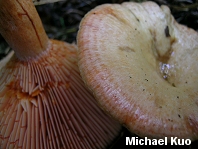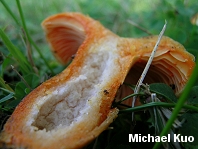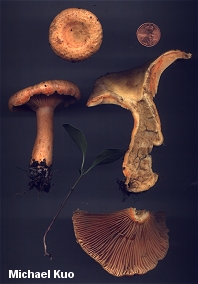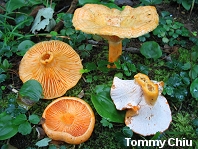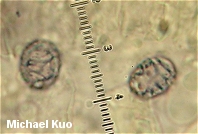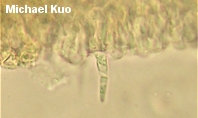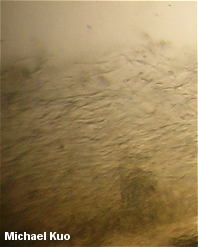| Major Groups > Gilled Mushrooms > Pale-Spored > Lactarius > Lactarius thyinos |

|
Lactarius thyinos [ Agaricomycetes > Russulales > Russulaceae > Lactarius . . . ] by Michael Kuo What a beautiful mushroom! Lactarius thyinos is found in cedar bogs in the northeastern U.S. and in Canada. It is easily identified: it is the only species of Lactarius that has orange milk and does not bruise green. It is often found growing alongside Lactarius deliciosus var. deterrimus, which also has orange milk and can look similar. Simply handling the two mushrooms will differentiate them, however; Lactarius deliciosus readily bruises green on all parts. Description: Ecology: Mycorrhizal with conifers, usually with northern white cedar; growing scattered or gregariously; summer and fall; northeastern North America and the upper Great Lakes region. Cap: 3-9 cm; at first convex, becoming flat, with a shallow central depression, or vase-shaped; slimy or thinly slimy when fresh; the margin arched; bald; zoned with concentric bands of carrot orange and paler orange. Gills: Attached to the stem or running slightly down it; close or nearly distant; orange; bruising brownish. Stem: 4-8 cm long; 1.5-2 cm thick; orange; more or less equal, or tapering somewhat to base; bald; hollow; sometimes slimy when young; often with a whitish sheen above; sometimes bruising dull red or brownish; sometimes with wide, shallow potholes. Flesh: Thin; white to orangish. Milk: Orange; unchanging when exposed; slowly staining tissues red. Odor and Taste: Odor faintly fragrant; taste mild. Chemical Reactions: KOH negative on cap surface. Spore Print: Whitish to pale yellow. Microscopic Features: Spores 9-12 x 7.5-9 µ; broadly ellipsoid to subglobose; ornamentation 0.5-1.0 µ high, as amyloid warts and ridges forming partial reticula. Pleuromacrocystidia scattered to abundant; subfusoid to subcylindric; to about 100 x 10 µ. Cheilocystidia fusoid; to about 60 x 10 µ. Pileipellis an ixocutis. REFERENCES: A. H. Smith, 1960. (Hesler & Smith, 1979; Smith, Smith & Weber, 1979; Arora, 1986; Phillips, 1991/2005; Barron, 1999; McNeil, 2006; Nuytinck et al., 2006; Kuo, 2007.) Herb. Kuo 09029403, 09050201. This site contains no information about the edibility or toxicity of mushrooms. |
© MushroomExpert.Com |
|
Cite this page as: Kuo, M. (2011, March). Lactarius thyinos. Retrieved from the MushroomExpert.Com Web site: http://www.mushroomexpert.com/lactarius_thyinos.html |
